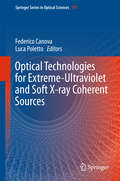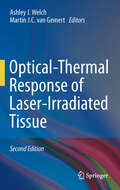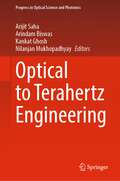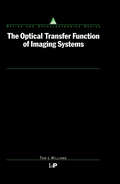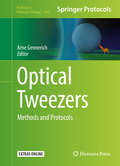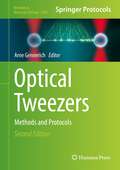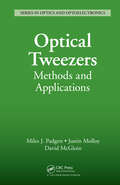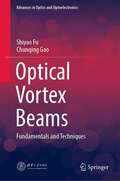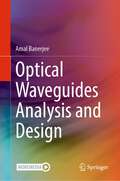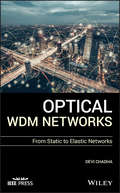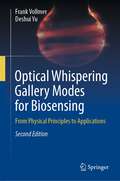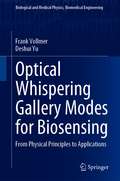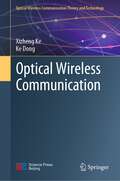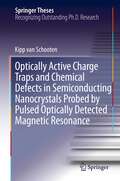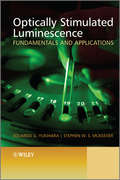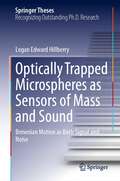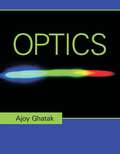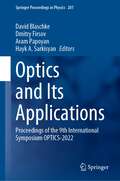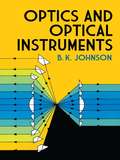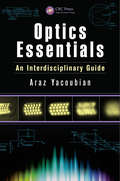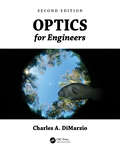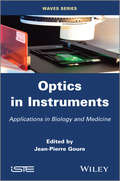- Table View
- List View
Optical Technologies for Extreme-Ultraviolet and Soft X-ray Coherent Sources
by Federico Canova Luca PolettoThe book reviews the most recent achievements in optical technologies for XUV and X-ray coherent sources. Particular attention is given to free-electron-laser facilities, but also to other sources available at present, such as synchrotrons, high-order laser harmonics and X-ray lasers. The optical technologies relevant to each type of source are discussed. In addition, the main technologies used for photon handling and conditioning, namely multilayer mirrors, adaptive optics, crystals and gratings are explained. Experiments using coherent light received during the last decades a lot of attention for the X-ray regime. Strong efforts were taken for the realization of almost fully coherent sources, e. g. the free-electron lasers, both as independent sources in the femtosecond and attosecond regimes and as seeding sources for free-electron-lasers and X-ray gas lasers. In parallel to the development of sources, optical technologies for photon handling and conditioning of such coherent and intense X-ray beams advanced. New problems were faced for the realization of optical components of beamlines demanding to manage coherent X-ray photons, e. g. the preservation of coherence and time structure of ultra short pulses.
Optical-Thermal Response of Laser-Irradiated Tissue
by Ashley J. Welch Martin J.C. GemertThe second edition maintains the standard of excellence established in the first edition, while adjusting the content to reflect changes in tissue optics and medical applications since 1995. The material concerning light propagation now contains new chapters devoted to electromagnetic theory for coherent light. The material concerning thermal laser-tissue interactions contains a new chapter on pulse ablation of tissue. The medical applications section now includes several new chapters on Optical Coherent Tomography, acoustic imaging, molecular imaging, forensic optics and nerve stimulation. A detailed overview is provided of the optical and thermal response of tissue to laser irradiation along with diagnostic and therapeutic examples including fiber optics. Sufficient theory is included in the book so that it is suitable for a one or two semester graduate or for senior elective courses. Material covered includes (1) light propagation and diagnostic application; (2) the thermal response of tissue and therapeutic application; (3) denaturation; and (4) ablation. The theory and applications provide researchers with sufficient detail that this volume will become the primary reference for laser-tissue interactions and medical applications.
Optical to Terahertz Engineering (Progress in Optical Science and Photonics #23)
by Arijit Saha Arindam Biswas Kankat Ghosh Nilanjan MukhopadhyayThis book highlights advances in the field of THz engineering along with limitations of radio frequency (RF) technology. All engineering applications have been designed to operate over a specific frequency or wavelength range in electromagnetic spectrum. In recent years, the unexplored domain of THz range of electromagnetic spectrum has paved the way for terahertz technology due to its nonionizing nature and sensitivity to water content. A wide range of applications with THz techniques such as terahertz time-domain spectroscopy (THz-TDS), biological, medical and pharmaceutical sciences, explosives inspection, information and communication technology (ICT) sector and many more, have potential to be the technology of future. Different designing aspects and evolving application areas are addressed to enrich the technical knowledge of readers. This book provides an overview of state of the art in terms of research and industrial progress in THz spectrum.
The Optical Transfer Function of Imaging Systems (Series In Optics And Optoelectronics Ser.)
by Thomas WilliamsThe Optical Transfer Function of Imaging Systems deals extensively with the theoretical concept of the optical transfer function (OTF), its measurement, and application to imaging devices. The OTF is a mathematical entity describing how well the subject is transferred into an image via the lens.The book focuses on the practical aspects of using and measuring the OTF. It presents the background physics necessary to understand and assess the performance of the great proliferation of electro-optical systems, including image intensifiers, video cameras, and thermal imagers. Assuming a senior undergraduate level of optics knowledge, the book is suitable for graduate courses in optics, electro-optics, and photographic science. In addition, it is a practical guide for systems designers who require a means of assessing and specifying the performance of imaging systems. It is also of interest to physicists and engineers working in all areas of imaging.
Optical Tweezers
by Arne GennerichThe aim of this volume is to provide a comprehensive overview of optical tweezers setups, both in practical and theoretical terms, to help biophysicists, biochemists, and cell biologists to build and calibrate their own instruments and to perform force measurements on mechanoenzymes both in isolation in vitro and in living cells. Chapters have been divided in three parts focusing on theory and practical design of optical tweezers, detailed protocols for performing force measurements on single DNA- and microtubule/actin-associated mechanoenzymes in isolation, and describing recent advances that have opened up quantitative force measurements in living cells. Written in the highly successful Methods in Molecular Biology series format, chapters include introductions to their respective topics, lists of the necessary materials and reagents, step-by-step, readily reproducible laboratory protocols, and tips on troubleshooting and avoiding known pitfalls. Authoritative and cutting-edge, Optical Tweezers: Methods and Protocols aims help to further expand the accessibility and use of optical traps by scientists of diverse disciplines.
Optical Tweezers: Methods and Protocols (Methods in Molecular Biology #2478)
by Arne GennerichThis detailed volume explores a wide variety of techniques involving optical tweezers, a technology that has become increasingly more accessible to a broad range of researchers. Beginning with recent technical advances, the book continues by covering the application of optical tweezers to study DNA-protein interactions and DNA motors, protocols to perform protein (un)folding experiments, the application of optical tweezers to study actin- and microtubule-associated motor proteins, and well as protocols for investigating the function and mechanical properties of microtubules and intermediate filaments, and more. Written for the highly successful Methods in Molecular Biology series, chapters include introductions to their respective topics, lists of the necessary materials and reagents, step-by-step, readily reproducible laboratory protocols, and tips on troubleshooting and avoiding known pitfalls. Authoritative and practical, Optical Tweezers: Methods and Protocols, Second Edition serves as an ideal resource for expanding the accessibility and use of optical traps by scientists of diverse disciplines.
Optical Tweezers: Methods and Applications
by Miles J. Padgett Justin E. Molloy David McGloinThe technical development of optical tweezers, along with their application in the biological and physical sciences, has progressed significantly since the demonstration of an optical trap for micron-sized particles based on a single, tightly focused laser beam was first reported more than twenty years ago. Bringing together many landmark papers on
Optical Vortex Beams: Fundamentals and Techniques (Advances in Optics and Optoelectronics)
by Shiyao Fu Chunqing GaoThis book focuses on optical vortices, including beams carrying orbital angular momentum and vector beams. It presents an overview of, and the latest research on this novel type of optical beam, which is a hot topic in the domain of modern optics, especially in optical communication and beam manipulation. Summarizing the fundamentals of optical vortices, it discusses their characterization and propagation, and focuses on the generation of vortices such as vortex-arrays, and the detection of vortices and their orbital angular momentum state. It also comprehensively examines the adaptive compensation systems, as well as vector beams and polarization vortices with anisotropic polarization distributions. Further it provides a detailed description of perfect vortices with beam diameters independent of the angular momentum. This book is intended for researchers, engineers and graduate students working in the field of optics and laser beam applications.
Optical Waveguides Analysis and Design
by Amal BanerjeeThis book offers readers a comprehensive, detailed analysis and treatment of optical waveguides (fiber, slab), an essential component of ultra-high bandwidth long, medium and short-haul telecommunication. The author describes an analysis scheme for optical waveguides that combines both geometric|ray optics and Maxwell’s equations-based classical electrodynamics. This unique approach enables readers to develop an intuitive understanding of this topic, starting with macro properties, e.g., V parameter of an optical fiber, and progressively refining the analysis to individual modes of propagation through an optical waveguide. An exhaustive set of diagrams highlight the key features of an optical waveguide property, such as acceptance angle, meridional and skew rays in an optical fiber, or signal attenuation and dispersion in an optical waveguide. The author also provides a set of ready-to-use, ANSI C executables (for both Linux and Windows) that enable the reader to e.g, determine the allowed propagation modes (even, odd TE|TM) of a graded, step index optical fiber and a slab waveguide.Offers readers a single-source reference to the analysis and design of optical waveguides;Begins with macro-level analysis of the properties of optical waveguides and dives deeply into details in a step-by-step manner, enabling readers to develop an intuitive understanding;Includes C language executables, along with optical waveguide analysis and design examples to demonstrate their use in context.
Optical Waves in Waveguides and Free Space: Multimode Propagation (Springer Series in Optical Sciences #251)
by Junhe Zhou Meisong TongThis book provides a thorough review of multi-mode propagation inside optical waveguides and free space, which is receiving particular attention for its promising applications in communications and sensing. At the heart of the book is the matter of how modes couple and interfere due to engineered or random index fluctuations, forming functional devices. The chapters cover topics such as multi-mode interference, coupled mode theory, and mode generation. Readers discover how a universal coupled mode theory can describe mode propagation, enabling stochastic analysis and avoiding time-consuming simulations. The book also delves into mode division multiplexing systems and digital signal processing (DSP) algorithm-enabled multiple-input multiple-output (MIMO) transmission in multi-mode systems. Researchers in the field of optical communications and for physicists and engineers will find this book to be invaluable. It offers a comprehensive review of multi-mode transmission systems' basic physics and applications, making it essential for anyone interested in advancing their understanding of this rapidly expanding field.
Optical WDM Networks: From Static to Elastic Networks (Wiley - IEEE)
by Devi ChadhaProvides a comprehensive and updated account of WDM optical network systems Optical networking has advanced considerably since 2010. A host of new technologies and applications has brought a significant change in optical networks, migrating it towards an all-optical network. This book places great emphasis on the network concepts, technology, and methodologies that will stand the test of time and also help in understanding and developing advanced optical network systems. The first part of Optical WDM Networks: From Static to Elastic Networks provides a qualitative foundation for what follows—presenting an overview of optical networking, the different network architectures, basic concepts, and a high-level view of the different network structures considered in subsequent chapters. It offers a survey of enabling technologies and the hardware devices in the physical layer, followed by a more detailed picture of the network in the remaining chapters. The next sections give an in-depth study of the three basic network structures: the static broadcast networks, wavelength routed networks, and the electronic/optical logically routed networks, covering the characteristics of the optical networks in the access, metropolitan area, and long-haul reach. It discusses the networking picture; network control and management, impairment management and survivability. The last section of the book covers the upcoming technologies of flex-grid and software defined optical networking. Provides concise, updated, and comprehensive coverage of WDM optical networks Features numerous examples and exercise problems for the student to practice Covers, in detail, important topics, such as, access, local area, metropolitan, wide area all-optical and elastic networks Includes protocols, design, and analysis along with the control and management of the networks Offers exclusive chapters on advance topics to cover the present and future technological trends, such as, software defined optical networking and the flexible grid optical networks Optical WDM Networks: From Static to Elastic Networks is an excellent book for under and post graduate students in electrical/communication engineering. It will also be very useful to practicing professionals in communications, networking, and optical systems.
Optical Whispering Gallery Modes for Biosensing: From Physical Principles to Applications
by Frank Vollmer Deshui YuThis interdisciplinary book covers the fundamentals of optical whispering gallery mode (WGM) microcavities, light–matter interaction, and biomolecular structure with a focus on applications in biosensing. Novel biosensors based on the hybridization of WGM microcavities and localized surface plasmon resonances (LSPRs) in metal nanoparticles have emerged as the most sensitive microsystem biodetection technology that boasts single molecule detection capability without the need for amplification and labeling of the analyte. The book provides an ample survey of the physical mechanisms of WGMs and LSPRs for detecting affinity, concentration, size, shape and orientation of biomarkers, while informing the reader about different classes of biomolecules, their optical properties and their importance in label-free clinical diagnostics.This expanded and updated second edition features a new chapter that introduces the reader to advanced in vivo biosensing techniques using WGM microcavities, looking at photothermal sensing, methods for trapping neutral atoms around WGM microcavities, and practical aspects of optoplasmonic sensing. The second Edition now provides a comprehensive introduction to the use of WGM microcavities in physical sensing which includes measurements with frequency combs, macro and micro (one atom) lasers, gyroscopes, optomechanical and parity-time-symmetric sensor devices.Chapter-end problems round out this comprehensive and fundamental textbook, inspiring a host of up-and-coming physicists, bioengineers, and medical professionals to make their own breakthroughs in this blossoming new field. This textbook can be used for both introductory and advanced courses about the modern optics of optical microcavities.
Optical Whispering Gallery Modes for Biosensing: From Physical Principles to Applications (Biological and Medical Physics, Biomedical Engineering)
by Frank Vollmer Deshui YuThis interdisciplinary book covers the fundamentals of optical whispering gallery mode (WGM) microcavities, light–matter interaction, and biomolecular structure with a focus on applications in biosensing. Novel biosensors based on the hybridization of WGM microcavities and localized surface plasmon resonances (LSPRs) in metal nanoparticles have emerged as the most sensitive microsystem biodetection technology that boasts single molecule detection capability without the need for amplification and labeling of the analyte. The book provides an ample survey of the physical mechanisms of WGMs and LSPRs for detecting affinity, concentration, size, shape and orientation of biomarkers, while informing the reader about different classes of biomolecules, their optical properties and their importance in label-free clinical diagnostics. For the more advanced reader, advanced applications of WGMs and LSPRs in exploring the fundamental nature of quantum physics are discussed.
Optical Wireless Communication (Optical Wireless Communication Theory and Technology)
by Xizheng Ke Ke DongThe book gives a detailed description of optical wireless communication (OWC), including optical laser communication, visible light communication, ultraviolet communication, underwater optical communication and future communication technologies. To achieve an integration between theory and practice, the book avoids tedious mathematical deductions and includes theoretical materials as exercises. Most of the exercises are originated from published journal articles. These exercises will aid the readers in understanding the basic concept and methods and evaluating their knowledge acquisition in the field of OWC. The book is structured into Ten chapters that covers main aspects of OWC: - Optical wireless communication system - Coherent optical communication - Modulation, demodulation, and coding - Atmospheric channel, channel estimation, and channel equalization - White LED communication - Underwater laser communication - Ultraviolet communication - Acquisition, aiming, and tracking technology - Partially coherent optical transmission - Optical communication in the future The book is a suitable reference for undergraduate or postgraduate students majored in communication engineering, electronic information engineering or computer science, as well as the engineers and technicians in related fields.
Optically Active Charge Traps and Chemical Defects in Semiconducting Nanocrystals Probed by Pulsed Optically Detected Magnetic Resonance
by Kipp Van SchootenColloidal nanocrystals show much promise as an optoelectronics architecture due to facile control over electronic properties afforded by chemical control of size, shape, and heterostructure. Unfortunately, realizing practical devices has been forestalled by the ubiquitous presence of charge "trap" states which compete with band-edge excitons and result in limited device efficiencies. Little is known about the defining characteristics of these traps, making engineered strategies for their removal difficult. This thesis outlines pulsed optically detected magnetic resonance as a powerful spectroscopy of the chemical and electronic nature of these deleterious states. Counterintuitive for such heavy atom materials, some trap species possess very long spin coherence lifetimes (up to 1.6 µs). This quality allows use of the trapped charge's magnetic moment as a local probe of the trap state itself and its local environment. Beyond state characterization, this spectroscopy can demonstrate novel effects in heterostructured nanocrystals, such as spatially-remote readout of spin information and the coherent control of light harvesting yield.
Optically Stimulated Luminescence
by Stephen W. Mckeever Eduardo G. YukiharaOptically stimulated luminescence has developed into one of the leading optical techniques for the measurement and detection of ionizing radiation. This text covers, in a readable manner, advanced modern applications of the technique, how it can play a useful role in different areas of dosimetry and how to approach the challenges presented when working with optically stimulated luminescence.The six chapters are as follows:Introduction, including a short history of OSL and details of successful applications Theory and Practical Aspects Personal Dosimetry Space Dosimetry Medical Dosimetry Other Applications and Concepts, including retrospective and accident dosimetry, environmental monitoring and UV dosimetry Throughout the book, the underlying theory is discussed on an as-needed basis for a complete understanding of the phenomena, but with an emphasis of the practical applications of the technique. The authors also give background information and relevant key references on each method, inviting the reader to explore deeper into the subject independently.Postgraduates, researchers, and those involved with radiation dosimetry will find this book particularly useful. The material is both relevant and accessible for both specialists and those new to the field, therefore is fundamental to any academic interested in modern advances of the subject.
Optically Trapped Microspheres as Sensors of Mass and Sound: Brownian Motion as Both Signal and Noise (Springer Theses)
by Logan Edward HillberryThis thesis makes significant advances in the use of microspheres in optical traps as highly precise sensing platforms. While optically trapped microspheres have recently proven their dominance in aqueous and vacuum environments, achieving state-of-the-art measurements of miniscule forces and torques, their sensitivity to perturbations in air has remained relatively unexplored. This thesis shows that, by uniquely operating in air and measuring its thermally-fluctuating instantaneous velocity, an optically trapped microsphere is an ultra-sensitive probe of both mass and sound. The mass of the microsphere is determined with similar accuracy to competitive methods but in a fraction of the measurement time and all while maintaining thermal equilibrium, unlike alternative methods. As an acoustic transducer, the air-based microsphere is uniquely sensitive to the velocity of sound, as opposed to the pressure measured by a traditional microphone. By comparison to state-of-the-art commercially-available velocity and pressure sensors, including the world’s smallest measurement microphone, the microsphere sensing modality is shown to be both accurate and to have superior sensitivity at high frequencies. Applications for such high-frequency acoustic sensing include dosage monitoring in proton therapy for cancer and event discrimination in bubble chamber searches for dark matter. In addition to reporting these scientific results, the thesis is pedagogically organized to present the relevant history, theory, and technology in a straightforward way.
Optics
by Ajoy GhatakOptics by Professor Ghats is a classic text designed to provide a comprehensive account of important topics in this exciting field. The book aims to meet the requirements of a course on Optics for undergraduate students of science and engineering. This brand new multi-colour edition comes with a number of careful revisions in the text and colourful illustrations, thus making it even more exciting and reader friendly.
Optics and Its Applications: Proceedings of the 9th International Symposium OPTICS-2022 (Springer Proceedings in Physics #281)
by David Blaschke Dmitry Firsov Aram Papoyan Hayk A. SarkisyanThis book features selected articles based on contributions presented at the 9th International Symposium on Optics and Its Applications (OPTICS-2022) in Yerevan-Ashtarak, Armenia. The annual OPTICS symposium brings together renowned experts from all over the world working in the fields of atomic optics, plasmonics, optics of nanostructures, as well as the optics of condensed matter, and provides a perfect setting for their discussions of the most recent developments in this area.The 9th iteration in this series, dedicated to the 80th birthday of Academician Eduard Kazaryan, focuses on topics dealing with the spectroscopy of real and artificial atoms, linear and nonlinear optical characteristics of quantum wells, and two-dimensional materials. The book highlights recent results of few-particle optical characteristics of artificial atoms in the framework of the exactly solvable Moshinsky model, as well as an electro-optical analog of the magneto-optical Faraday effect. In addition, a detailed study of the nucleation process, its characterization, as well as electronic and optical properties of graded composition quantum dots in the Stranski−Krastanov growth mode, is presented.
Optics and Optical Instruments: An Introduction
by B. K. JohnsonThis book illustrates basic practical applications of optical principle. Working models of telescopes, microscopes, photographic lenses, and optical projection systems are diagrammed and explained in full, as are the basic experiments for determining accuracy, power, angular field of view, amount of aberration, and all other necessary facts about the instrument. Throughout the book, only elementary mathematics is used, for the benefit of the student and the beginner in the field of optics.The author, an assistant professor at the Imperial College of Science and Technology in London, shows how to set up working models of each of the four types of instruments named above, so that the reader can see for himself the effects of changing the focal length, using different types of lenses, rotating the lens, and other experiments. He also includes a number of experiments to illustrate theoretical principles such as the reflection and refraction of light and focal length measurements of concave and convex lenses.A chapter on the human eye follows, and the author explains how to set up a simple working model of the eye in order to illustrate myopia, astigmatism, hypermetropia, and the visual acuity of the eye. Professor Johnson concludes with an important chapter on the working and testing of optical glass, in which he describes the roughing of lenses, the principles of the grinding and polishing processes, abrasives, edging, angle measurement, and other important steps in the production of optical glass. An appendix is included on the cleaning of glass surfaces, silvering, photographic items, developers, collodion films, and waxes and cements used for various purposes in optical work.This is a valuable work for the student and the amateur hobbyist as well as for many who use optical instruments in science and industry. It is written clearly and economically, with the needs of the practical worker in the field of optics held constantly in mind.
Optics and Photonics
by Committee on Harnessing Light: Capitalizing on Optical Science Trends Challenges for Future ResearchOptics and photonics technologies are ubiquitous: they are responsible for the displays on smart phones and computing devices, optical fiber that carries the information in the internet, advanced precision manufacturing, enhanced defense capabilities, and a plethora of medical diagnostics tools. The opportunities arising from optics and photonics offer the potential for even greater societal impact in the next few decades, including solar power generation and new efficient lighting that could transform the nation's energy landscape and new optical capabilities that will be essential to support the continued exponential growth of the Internet. As described in the National Research Council report Optics and Photonics: Essential Technologies for our Nation, it is critical for the United States to take advantage of these emerging optical technologies for creating new industries and generating job growth. The report assesses the current state of optical science and engineering in the United States and abroad--including market trends, workforce needs, and the impact of photonics on the national economy. It identifies the technological opportunities that have arisen from recent advances in, and applications of, optical science and engineering. The report also calls for improved management of U. S. public and private research and development resources, emphasizing the need for public policy that encourages adoption of a portfolio approach to investing in the wide and diverse opportunities now available within photonics. Optics and Photonics: Essential Technologies for our Nation is a useful overview not only for policymakers, such as decision-makers at relevant Federal agencies on the current state of optics and photonics research and applications but also for individuals seeking a broad understanding of the fields of optics and photonics in many arenas.
Optics Essentials: An Interdisciplinary Guide
by Araz YacoubianA Valuable Reference for Understanding Basic Optical Principals Need a crash course in optics? If you are a non-specialist with little or no knowledge of optical components, systems, or hardware, who suddenly finds it necessary to work with optics in your given field, then Optics Essentials: An Interdisciplinary Guide is the book for you. Aimed at engineers and other interdisciplinary professionals tackling optics-related challenges, this text provides a basic overview of optical principles, concepts, and applications as well as worked examples throughout. It enables readers to gain a basic understanding of optics and sense of optical phenomena, without having to commit to extended periods of study. Contains MATLAB® Simulations and Suggested Experiments The book provides MATLAB simulations to help the reader visualize concepts, includes simple experiments using everyday materials that are readily available to solidify optical principles, and provides worked examples throughout. It contains a set of suggested experiments in each chapter designed to help the reader understand and visualize the basic principles. While this book assumes that the reader has a basic background in mathematics, it does not burden or overwhelm them with complex information or heavy mathematical equations. In addition, while it also briefly discusses advanced topics, readers are directed to the appropriate texts for more detailed study. Comprised of 11 chapters, this illuminating text: Describes light sources, such as lasers, light-emitting diodes, and thermal sources Compares various light sources, and photometric and radiometric parameters Discusses light detection, including various detector types, such as photon detectors and thermal detectors, and other topics relating to light detection Addresses manipulation of light, and covers reflection, refraction, diffraction and interference, absorption, and scattering Factors in polarization Explores the basic principles of geometrical optics, covering ray tracing and formulation based on the assumption that light comprises of optical "rays" Defines imaging systems and topics related to imaging systems Refers to guiding light waves Considers various topics related to optics, electronics, software, and applications Covers combining optical systems with electronics and software Presents various optical sensing phenomena and different types of sensors Optics Essentials: An Interdisciplinary Guide simplifies optical principles to make it easy to grasp by technical professionals that are outside of the optical field, and serves industry professionals, technical managers, researchers, and students.
Optics for Engineers
by Charles A. DiMarzioThis textbook provides an accessible introduction to the fundamentals of geometric and physical optics as they relate to practical problems encountered by engineers and researchers in designing and analyzing optical systems.In this updated edition, the author focuses on topics that are critical to understanding how the basic principles of optics affect design decisions. In addition to information on breadboarding experiments and prototypes, the new edition also expands its coverage of diffraction and includes numerous complete examples, and practical remindersProfessor Charles A. DiMarzio is an associate professor in the Department of Electrical and Computer Engineering, the Department of Mechanical and Industrial Engineering, and the Department of Bioengineering at Northeastern University in Boston, Massachusetts. He spent 14 years at Raytheon Company’s Electro-Optics Systems Laboratory in coherent laser radar for air safety and meteorology. Among other projects there, he worked on an airborne laser radar, flown on the Galileo-II, to monitor airflow related to severe storms, pollution, and wind energy, and another laser radar to characterize the wake vortices of landing aircraft. His current research in biomedical optics focuses on microscopy including coherent imaging, structured illumination, and multi-modal imaging. He is also a founding member of Gordon-CenSSIS – the Gordon Center for Subsurface Sensing and Imaging Systems.
Optics in Instruments: Applications in Biology and Medicine (Wiley-iste Ser.)
by Jean-Pierre GoureOptics is a science which covers a very large domain and is experiencing indisputable growth. It has enabled the development of a considerable number of instruments, the optical component or methodology of which is often the essential part of portent systems. This book sets out show how optical physical phenomena such as lasers – the basis of instruments of measurement – are involved in the fields of biology and medicine. Optics in Instruments: Applications in Biology and Medicine details instruments and measurement systems using optical methods in the visible and near-infrared, as well as their applications in biology and medicine, through looking at confocal laser scanning microscopy, the basis of instruments performing in biological and medical analysis today, and flow cytometry, an instrument which measures at high speed the parameters of a cell passing in front of one or more laser beams. The authors also discuss optical coherence tomography (OCT), which is an optical imaging technique using non-contact infrared light, the therapeutic applications of lasers, where they are used for analysis and care, and the major contributions of plasmon propagation in the field of life sciences through instrumental developments, focusing on propagating surface plasmons (PSP) and localized plasmons (LP). Contents: 1. Confocal Laser Scanning Microscopy, Thomas Olivier and Baptiste Moine. 2. Flow Cytometry (FCM) Measurement of Cells in Suspension, Odile Sabido. 3. Optical Coherence Tomography, Claude Boccara and Arnaud Dubois. 4. Therapeutic Applications of Lasers, Geneviève Bourg-Heckly and Serge Mordon. 5. Plasmonics, Emmanuel Fort. About the Authors Jean-Pierre Goure is Emeritus Professor of optics at Jean Monnet University in Saint-Etienne, France, and was previously director of the UMR 5516 laboratory linked with CNRS. He is the author of more than 100 publications in various fields, such as spectroscopy, instrumentation, sensors, optical fiber and optical communications. He was also previously deputy director in engineering science at CNRS and a member of several scientific associations such as the French Optical Society and the European Optical Society.
